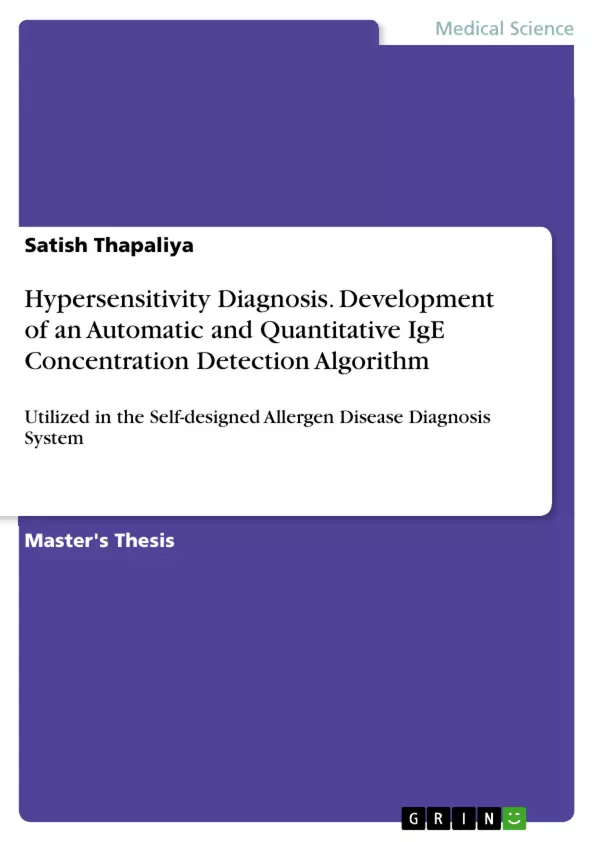Allergic diseases are seen to affect a large number of people around the world every year. The proper diagnosis of allergic disease is an important factor to maintain the good health condition of a general population. Although there are several techniques available for the diagnosis of allergic disease, most of the methods fail to cover all of the criteria to make it acceptable.
This study introduces general methods of allergy diagnosis which are in practice in current scenario and different image processing techniques that can be incorporated into it to make the process even easier. In this study ELISA technique is proposed to fulfill all the basic criteria like sensitivity, accuracy and most importantly cost effectiveness. ELISA is an immunoassay that involves the detection of Immunoglobulin type E commonly referred as IgE. An enzyme linked anti-human globulin is made to react with IgE, if present in the patient's serum which will produce the colored product when the substrate of the enzyme is added. Depending upon the concentration of the colored product, the concentration of IgE is determined. The experiment condition like wet condition and plastic container can significantly change the detected color of the allergen card and hence the result value. This proves that the system environment indeed affects calculated IgE concentration. In order to reduce this negative effect, we need to find an effective image feature which is little influenced by system environment. The content of this study mainly focuses on different color models of the color images that can be used in image processing technology which are further utilized to define its relationship with IgE concentration or the severity of the disease. Involving the features of both binary and color image models it gives the better comparison of the different image features in different color models. These image features ware tested and result curves were produced that describes the relationship between IgE concentration and image feature. Based on the experimental findings the new diagnostic image feature was introduced. The experiments were done to test the accuracy of the proposed diagnostic image feature which is cheap, sensitive and can detect the IgE concentration quantitatively.
Inhaltsverzeichnis (Table of Contents)
- Abstract
- Chapter 1 Introduction
- 1.1 Background
- 1.2 Prevalence of Allergic Diseases
- 1.3 Current Methods of Allergy Diagnosis
- 1.4 Aim of the Study
- Chapter 2 Materials and Methods
- 2.1 Materials
- 2.2 Methods
- Chapter 3 Results and Analysis
- 3.1 Gray Value vs IgE Concentration
- 3.2 Multi Spectral Area vs IgE Concentration
- 3.3 Color Difference vs IgE Concentration
- Chapter 4 Discussion
- 4.1 Effect of System Environment
- 4.2 Comparison of G Channel in Wet and Dry Conditions
- 4.3 Comparison of Luma Intensity in Wet and Dry Conditions
- Chapter 5 Conclusion
Zielsetzung und Themenschwerpunkte (Objectives and Key Themes)
This dissertation aims to develop an automatic and quantitative IgE concentration detection algorithm for use in a self-designed allergen disease diagnosis system. It focuses on improving the accuracy and efficiency of allergy diagnosis through image processing techniques applied to ELISA results.
- Development of an automated IgE concentration detection algorithm
- Utilization of image processing techniques for allergy diagnosis
- Evaluation of the impact of system environment on IgE detection
- Quantitative analysis of IgE concentration based on image features
- Optimization of the diagnostic system for accuracy and cost-effectiveness
Zusammenfassung der Kapitel (Chapter Summaries)
Chapter 1 introduces the prevalence of allergic diseases and discusses current methods of allergy diagnosis, highlighting their limitations. The chapter outlines the aim of the study, which focuses on developing a new, automated and quantitative IgE detection algorithm for a self-designed allergen disease diagnosis system. Chapter 2 details the materials and methods used in the study, including the ELISA technique and image processing techniques. Chapter 3 presents the results and analysis of the experiments, focusing on the relationship between IgE concentration and different image features. Chapter 4 discusses the findings, particularly the effect of system environment on IgE detection and the comparison of various image features in different color models.
Schlüsselwörter (Keywords)
This study explores the use of image processing techniques for quantitative IgE detection in allergen disease diagnosis. The primary keywords are Allergic disease, Automatic Diagnosis, IgE, ELISA, and Quantitative Detection. The study utilizes various color models and image features to analyze the relationship between IgE concentration and the resulting images, aiming to create a more accurate and efficient diagnostic system.
- Citation du texte
- Satish Thapaliya (Auteur), 2014, Hypersensitivity Diagnosis. Development of an Automatic and Quantitative IgE Concentration Detection Algorithm, Munich, GRIN Verlag, https://www.grin.com/document/506858



